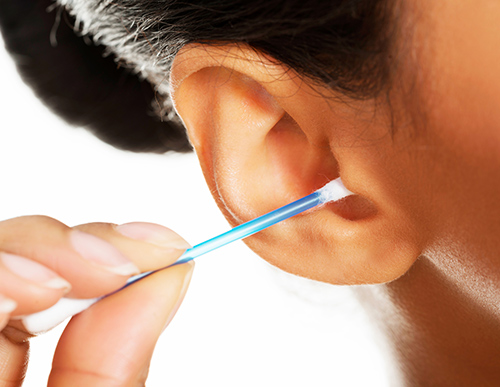
What do you do when something you thought was a good habit turns out to be a bad one? You drop it, of course. It turns out that ear cleaning with swabs is actually a bad, bad habit that can damage your ears. Ear health experts including your local hearing care professional, the American Academy of Otolaryngology-Head and Neck Surgery (AAO-HNS), the warning on your box of swabs and your grandmother agree that you should never stick anything bigger than your elbow into your ears. Here’s 5 reasons to stop cleaning your ears with swabs and let your ear wax do it for you:
1. Ears are Pretty Much Self-Cleaning
Ear wax is called cerumen by doctors and scientists lucky enough to study this amazing, but gross-looking substance. It actually snags stray dirt and dust that tries to enter your ear canal before it can get very far and cause problems. As if that wasn’t cool enough, without realizing it, you already help your ears clean themselves by just talking, chewing and yawning all day long. These jaw mechanics move the soiled ear wax out of the ear canal. All you have to do is gently wash that excess away while you’re showering.
And just know this: Using a swab, chopstick, paintbrush, key, fingernail, fork, key or any other small, pointy foreign object for ear wax removal actually frustrates your ears’ self-cleaning process. Digging around in there can actually push old, spent ear wax further into the ear canal where it becomes impacted and can dampen your hearing.
2. Let the Ear Wax Win
Sure, cerumen may look kinda gross, but your ceruminous and sebaceous glands make this special recipe for the health of your ears. In addition to effectively removing dust and crud out of your ear canal, ear wax guards your ears against bacteria, fungal infections and viruses. It even repels insects! It also protects and lubricates the inside of the ear canal to keep it healthy.
In fact, these glands whip up a special recipe of cholesterol, sebum, long-chain fatty acids, enzymes, alcohols, sloughed off skin cells, and other chemicals especially formulated for your personal ears—the end result is ear-protecting ear wax. Healthy cerumen is also slightly acidic—which very helpfully inhibits fungal and bacterial growth. Thanks, ear wax!
3. Hearing Loss and Ear Cleaning
If you’re one of the millions of people who have been using swabs to clean their ears over the years, it’s possible you’ve already suffered some level of hearing loss. That’s because you may have shoved some dirty old ear wax down your ear canal in the swabbing process, clogging your ear canal and blocking hearing. The best thing to do is schedule an appointment with your hearing care professional for a hearing checkup to determine whether or not you have impacted ear wax that might be causing some amount of hearing loss. Impacted ear wax removal should only be done in the office.
Also, there are some people who have actual ear wax problems that need to be addressed with ear wax removal—but still not with swabs. Some people’s ears make it too dry or too wet. Sometimes the chemical composition is off and it doesn’t do its job properly. Even in these cases, however, you should still shun sticking anything into your ears besides your elbow for ear wax removal or evaluation. Call your hearing care professional if you’re worried about your ear wax.
Note about hearing aids: ear wax buildup can lessen the effectiveness of your hearing aids, if you wear them. Improper hearing aid cleaning can also cause ear wax jams. So it’s very important to follow any hearing aid cleaning and gentle ear washing instructions that your hearing care professional gives you.
4. Avoid Ear Cleaning Injuries Like These
It’s important for parents the world over to understand that ear cleaning is not necessary like brushing your teeth is! Every day, somewhere in America, 34 kids are rushed to the doctor with ear cleaning injuries. Unfortunately, these injuries sometimes cause hearing loss that impacts the child’s language and communication development. So teach your kids not to put anything in their ears except their elbows (and then giggle as they try to do it). But seriously, the most common of these ear injuries include tympanic membrane tears (torn ear drum) or other small lacerations and cuts inside of the ear canal.
We hear some of you out there thinking out loud about “ear candling”. Nobody knows exactly who thought of sticking these hollow cones into your ear and setting them on fire, but we’re here to tell you—it doesn’t work, and it’s dangerous. So don’t do it. People across the country end up in the doctor’s office with ear candling injuries every year.
Need to know facts about ear candling:
- It’s been proven ineffective for ear cleaning and can actually make ear wax impaction worse.
- It causes burn injuries to the face, ears, hair, etc. – even burns that go all the way to the ear drum and middle ear.
- It’s also been known to puncture the ear drum.
So just… don’t do it!
5. There is One Safe Way to Clean Your Ears…
Showering. Really, just take your shower and wash your hair. Afterwards, just gently dab around your ears with a towel to sop up any excess water and you’re good to go. This will safely remove only the spent ear wax that your chewing, talking and yawning have evacuated from the ear canal.
Seriously – don’t pick up another swab! If not cleaning your ears the wrong way makes you feel awkward, or if you have any other concerns about ear wax impaction, ear injury or hearing loss, please schedule an appointment with your hearing care professional for an ear checkup today.

